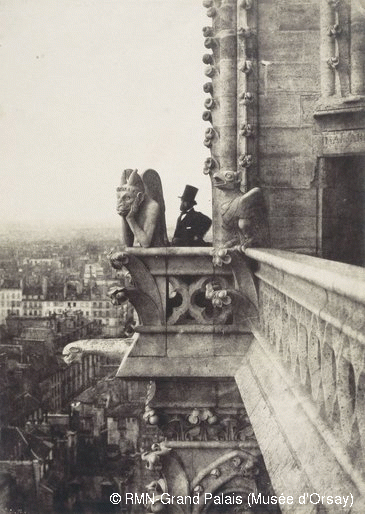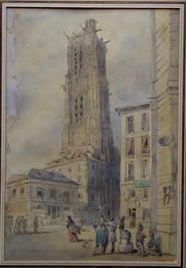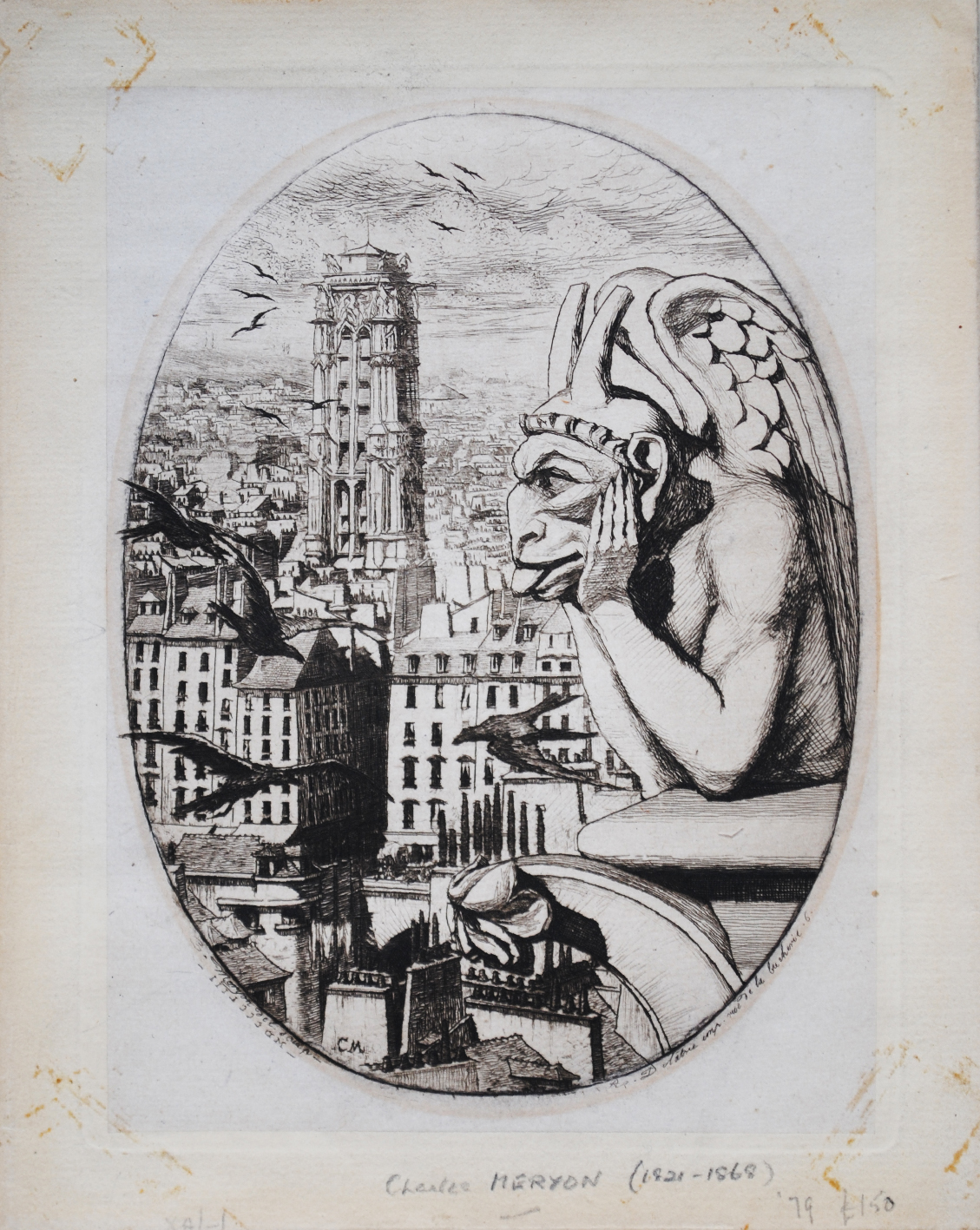|

|
|
Le Stryge
Delteil 23, Wright
23, Schneiderman 27
etching with drypoint, 1853 (and later, according to Schneiderman),
on chine-appliqué on laid paper with the HUDELIST watermark, the 6th
state (of 10), after removal of the stanza*, but before the added
title, a very fine impression, with very wide margins (unfortunately
folded back to 200x160mm), annotations in the lower margin by the
collector, faint traces of
discolouration in the oval from an old mount, some slight staining from
tape (recto) in the old mount at the corners, just outside the image,
rather extensive staining from the old mount laterally, well away from
the image, annotations by the collector in pencil, below, otherwise in
very good
condition
P. 169x130mm., S. 490x320mm
|
Provenance: the Philip Adrian
Coates Collection, UK, and originally from C. W. Dowdeswell, with the wetstamp on the reverse (L. 690)
Meryon's penchant for fantastic themes here
sets the famous chimera of Notre Dame, grimacing over a Parisian
cityscape, against the Tour Saint Jacques in the background. The
title derives froma
monster in Greek mythology (characterised by a woman's head,
the body of a bird, and rapacious talons), which was thought to suck
the lifeblood of newborn children; the commonplace representation of
this horrific figure dates to the Middle Ages, and was often related to
practices of sorcery.
 Although often considered to be a Medieval gargoyle, this sculpture is in fact neither. A gargoyle is an
outcropping structure used to evacuate water from the edifice, which this is not. And the sculpture is indeed late; it was designed by Viollet-le-Duc, who
undertook the restoration of Notre Dame in 1845, and the present Galerie des Chimères is merely one of his rather more fanciful embellishments. (See photograph, left, taken in 1853, the same year as Meryon's etching, by Charles Négre.)
Although often considered to be a Medieval gargoyle, this sculpture is in fact neither. A gargoyle is an
outcropping structure used to evacuate water from the edifice, which this is not. And the sculpture is indeed late; it was designed by Viollet-le-Duc, who
undertook the restoration of Notre Dame in 1845, and the present Galerie des Chimères is merely one of his rather more fanciful embellishments. (See photograph, left, taken in 1853, the same year as Meryon's etching, by Charles Négre.)
It is probable though that
Meryon was les interested in the "authenticity" of the figure, in which
he instead saw the personnification of "Luxuria" (as Meryon referred to it in a letter to his father, cited by Schneiderman, page 56; see note below).
Schneiderman, page 56; see note below).
The Tour Saint Jacques (right) is a
vestige of the old church of Saint-Jacques-de-la-Boucherie, which
purportedly held relics of Saint James; the belltower dates to the early 16th
century, and is all that remains after the church was dismanteled
during the French Revolution. In 1852, the "délicieux tour de
Nicolas Flamel" was restored, which may well have prompted Meryon's
interest.
Impressions of this print on
chine appliqué are particularly rare, and we have only seen two on the
market in the past ten years: at the Galerie Gerda Bassenge sale, in
Berlin (November 26, 2009, Lot 5418), and the H. M. Petiet sale at
PIASA, Paris (June 5, 2008, Lot 145).

* The 4th state comprised
a two-line stanza that sheds light on Meryon's intent in representing
the lascivious nature of the figure:
Insatiable
vampire l'eternelle Luxure
Sur la Grande Cité convoite sa
pâture.
which he subsequently removed,
apparently for reasons of awkward versification. (see Schneiderman, p. 56)


 Although often considered to be a Medieval gargoyle, this sculpture is in fact neither. A gargoyle is an
outcropping structure used to evacuate water from the edifice, which this is not. And the sculpture is indeed late; it was designed by Viollet-le-Duc, who
undertook the restoration of Notre Dame in 1845, and the present
Although often considered to be a Medieval gargoyle, this sculpture is in fact neither. A gargoyle is an
outcropping structure used to evacuate water from the edifice, which this is not. And the sculpture is indeed late; it was designed by Viollet-le-Duc, who
undertook the restoration of Notre Dame in 1845, and the present  Schneiderman, page 56; see note below).
Schneiderman, page 56; see note below).